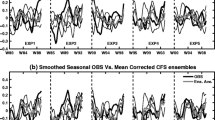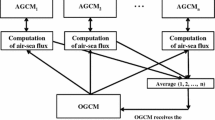Abstract
The impact of internal atmospheric variability on North Pacific sea surface temperature (SST) variability is examined based on three coupled general circulation model simulations. The three simulations differ only in the level of atmospheric noise occuring over the ocean at the air-sea interface. The amplitude of atmospheric noise is controlled by use of the interactive ensemble technique. This technique simultaneously couples multiple realizations of a single atmospheric model to a single realization of an ocean model. The atmospheric component models all experience the same SST, but the ocean component is forced by the ensemble averaged fluxes thereby reducing the impact of internal atmospheric dynamics at the air-sea interface. The ensemble averaging is only applied at the air-sea interface so that the internal atmospheric dynamics (i.e., transients) of each atmospheric ensemble member is unaffected. This interactive ensemble technique significantly reduces the SST variance throughout the North Pacific. The reduction in SST variance is proportional to the number of ensemble members indicating that most of the variability can simply be explained as the response to atmospheric stochastic forcing. In addition, the impact of the internal atmospheric dynamics at the air-sea interface masks out much of the tropical-midlatitude SST teleconnections on interannual time scales. Once this interference is reduced (i.e., applying the interactive ensemble technique), tropical-midlatitude SST teleconnections are easily detected.










Similar content being viewed by others
References
Alexander MA (1992) Midlatitude atmosphere-ocean interaction during El Nino, I. The North Pacific Ocean. J Clim 5: 944–958
Barnett TP, Pierce DW, Latif M, Dommenget D, Saravanan R (1999a) Interdecadal interactions between the tropics and midlatitudes in the Pacific basin. Geophys Res Lett 26: 1545–1566
Barnett TP, Pierce DW, Saravanan R, Schneider N, Dommenget D, Latif M (1999b) Origins of the midlatitude Pacific decadal variability. Geophys Res Lett 26: 1454–1456
Barsugli J, Battisti DS (1998) The basic effects of atmosphere-ocean thermal coupling on midlatitude variability. J Atmos Sci 55: 473–493
Deser C, Alexander MA, Timlin MS (1999) Evidence for a wind-driven intensification of the Kuroshio Current Extension from the 1970s to the 1980s. J Clim 12: 1697–1706
De Verdiere AC, Huck T (1999) Baroclinic instability: an oceanic wavemaker for interdecadal variability. J Phys Oceanogr 27: 893–910
Ebbesmeyer CC, Cayan DR, McLain DR, Nichols FH, Peterson DH, Redmond KT (1991) 1976 step in the Pacific climate: forty environmental changes between 1968–1975 and 1977–1984. Proc 7th Ann Pacific Climate Workshop, California, Department of Water Resource, Interagency Ecol Stud Prog, Tech Rep 26: 115–126
Frankignoul C, Hasselmann K (1977) Stochastic climate models: Part I. Application to sea surface temperature anomalies and thermocline variability. Tellus 29: 289–305
Frankignoul C, Muller P (1999) A cautionary note on the use of statistical atmospheric model in the middle latitudes: comments on “Decadal variability in the North Pacific as simulated by a hybrid coupled model”. J Clim 12: 1871–1872
Frankignoul C, Muller P, Zorita E (1997) A simple model of the decadal response of the ocean to stochastic wind forcing. J Phys Oceanogr 27: 1533–1546
Graham NE (1994) Decadal-scale climate variability in the tropical and North Pacific during the 1970’s and 1980’s: observations and model results. Clim Dyn 10: 135–162
Graham NE, Barnett TP, Wilde R, Ponator M, Schuber S (1994) On the roles of tropical and midlatitude SST’s in forcing interannul to interdecadal variability in the winter northern hemisphere circulation. J Clim 7: 1416–1441
Gershunov A, Barnett TP (1998) Interdecadal modulation of ENSO teleconnection. Bull Am Meteorol Soc 79: 2715–2725
Hasselmann K (1976) Stochastic climate models: Part I. Theory. Tellus 28: 473–485
Hoerling MP, Ting M, Kumar A (1995) Zonal flow-stationary wave relationship during El Nino: implications for seasonal forecasting. J Clim 8: 1838–1852
Jacobs GA, Hurlburt HE, Kindle JC, Metzger EJ, Mitchell JL, Teague WJ, Wallcraft AJ (1994) Decadal-scale trans-Pacific propagation and warming effects of an El Nino anomaly. Nature 370: 360–363
Jin FF (1997) A theory of interdecadal climate variability of the North Pacific atmosphere-ocean system. J Clim 10: 1821–1835
Kirtman BP, Shukla J (2002) Interactive coupled ensemble: a new coupling strategy for CGCMs. Geophys Res Lett 29: 1029–1032
Kirtman BP, Fan Y, Schneider EK (2002) The COLA global coupled and anomaly coupled ocean-atmosphere GCM. J Clim 15: 2301–2320
Latif M, Barnett TP (1994) Causes of decadal climate variability over the North Pacific and North America. Science 266: 634–637
Miller AJ, Schneider N (2000) Interdecadal climate regime dynamics in the North Pacific Ocean: theories, observations and ecosystem impacts. Progress in Oceanography, vol 27, Pergamon, Oxford pp 257–260
Miller AJ, Cayan DR, Barnett TP, Graham NE, Oberhuber JM (1994) Interdecadal variability of the Pacific Ocean: model response to observed heat flux and wind stress anomalies. Clim Dyn 9: 287–302
Miller AJ, Cayan DR, White WB (1998) A westward-intensified decadal change in the North Pacific thermocline and gyre-scale circulation. J Clim 11: 3112–3127
Nakamura H, Lin G, Yamagata T (1997) Decadal climate variability in the North Pacific during the recent decades. Bull Am Meteorol Soc 78: 2215–2225
Nitta T, Yamada S (1989) Recent warming of tropical sea surface temperature and its relationship to the Northern Hemisphere circulation. J Meteorol Soc Japan 67: 375–382
Pacanowski RC, Dixon K, Rosati A (1993) The GFDL modular ocean model users guide, version 1.0. GFDL Ocean Group Tech Rep 2, pp 77 (Available from GFDL/NOAA Princeton University, Princeton NJ 08542)
Pierce DW, Barnett TP, Latif M (2000) Connections between the Pacific ocean tropics and midlatitudes on decadal time scales. J Clim 13: 1173–1194
Pierce DW, Barnett TP, Shneider N, Saravanan R, Dommenget D, Latif M (2001) The role of ocean dynamics in producing decadal climate variability in the North Pacific. Clim Dyn 18: 51–70
Rosati A, Miyakoda K (1988) A general circulation model for upper ocean circulation. J Phys Oceanogr 18: 1601–1626
Saravanan R, McWilliams JC (1998) Advective ocean/atmosphere interactions: an analytical stochastic model with implications for decadal variability. J Clim 11: 165–188
Schneider N, Miller AJ, Pierce DW (2002) Anatomy of North Pacific decadal variability. J Clim 15: 586–605
Seager R, Kushnir Y, Naik N, Cane MA, Miller JA (2001) Wind-driven shifts in the latitude of the Kuroshio-Oyashio Extension and generation of SST anomalies on decadal time scales. J Clim 14: 4249–4265
Trenberth KE (1990) Recent observed interdecadal climate changes in the Northern Hemisphere. Bull Am Meteorol Soc 71: 988–993
Trenberth KE, Hurrell JW (1994) Decadal atmosphere-ocean variations in the Pacific. Clim Dyn 9: 303–319
Weng WJ, Neelin JD (1998) On the role of ocean-atmosphere interaction in midlatitude interdecadal variability. Geophys Res Lett 25: 167–170
Xie SP, Kunitani T, Kubokawa A, Nonaka M, Hosoda S (2000) Interdecadal thermocline variability in the North Pacific for 1958–97: a GCM simulation. J Phys Oceanogr 8: 18–24
Yeh S-W, Kirtman BP (2002) The characteristics of signal and versus noise SST variability in the North Pacific and the Tropical Pacific Ocean. COLA Rep 128, Center for Ocean-Land-Atmosphere Studies, pp 20. (Available from the Center for Ocean-Land-Atmosphere Studeis, 4041 Power Mill Road, Suite 302, Calverton, MD 20705, USA)
Yeh S-W, Kirtman BP (2003) On the relationship between the interannual and decadal SST variability in the North Pacific and tropical Pacific Ocean. J Geophys Res (in press)
Zhang Y, Wallace JM, Battisti DS (1997) ENSO-like intedecadal variability: 1900–93. J Clim 10: 1004–1020
Acknowledgements
The authors are indebted to B. Huang and D. Straus for their careful reading. This research was supported by grants from the National Science Foundation ATM-9814295 and ATM-0122859, the National Oceanic and Atmospheric Administration NA16-GP2248 and National Aeronautics and Space Administration NAG5-11656.
Author information
Authors and Affiliations
Corresponding author
Appendix
Appendix
The traditional “null hypothesis” for low frequency climate variability in the mid-latitude oceans is due to Hasselmann (1976). Hasselmann’s hypothesis postulates that the atmosphere, which is modeled as stochastic noise forcing, generates low-frequency SST variability via a red noise oceanic response. In this Appendix we describe what would be expected in comparing the variances from the interactive ensemble and the standard coupled model under the condition that the null hypothesis is valid. In this null hypothesis, the atmosphere is viewed as a stochastic weather noise generator and the ocean is a red noise filter. Coupled air-sea interactions are modeled as stable feedbacks. The simplest form of this model can be written as
where A is the atmospheric flux, O is the SST, α and β are the coupling parameters, and N and P represent Gaussian white noise forcing. The coupling parameters are stable (0 < α, β < 1). With these assumptions the SST variance (σ o 2) can be written as
where the respective noise variances of the atmosphere and the ocean are denoted by σ N 2 and σ P 2. In a similar fashion, we can write the null hypothesis version of the interactive ensemble as
where each of the atmospheric noise realizations are drawn from the same population. The SST variance in the interactive ensemble (σ oo 2) is given by
and ratio of the variances is given by
There are a few limits to the ratio that are worth noting. First, in the limit of very large ensemble sizes the ratio is given by
If, in addition, we assume that the ocean noise and the atmospheric noise are comparable, then the variance ratio lies somewhere between 0.5 and 1. Second, if we assume that the ocean noise is small compared to the atmospheric noise then A5 implies that the variance ratio is given by
Third, if the null hypothesis correct and the ocean noise is relatively small, then the ratio converges to zero for very large ensembles. In this case the variability in the interactive ensemble model goes to zero.
Figure 11 shows the variance ratio (i.e., Eq. 5) for three different values of the coupling parameter β as a function of noise variance ratio (σ P 2/σ N 2). The curves plotted in Fig. 11 correspond to assuming six ensemble members for the interactive ensemble. For weak coupling (β = 0.25), the variance ratio becomes relatively large for relatively small values of ocean noise. This is as expected. If the coupling is weak then the ocean noise has a large effect on the total variance. As the coupling strength increases the variance ratio approaches one only with considerably larger values of the oceanic noise. In this case, the coupling is more important and the ocean noise has a smaller impact.
In order to interpret the CGCM results presented, it is useful to consider three ranges of values for the ratio of the variances.
-
1.
If the ratio is on the order of 1/M as in A7, we conclude that the null hypothesis is likely to be correct (i.e., the variability is behaving like stochastically forced system with stable coupled feedbacks) and the ocean noise is relatively small.
-
2.
if the variance ratio is between 0.5 and 1.0 then either the null hypothesis is correct and the ocean noise is playing a significant role or the null hypothesis is incorrect and there are unstable coupled feedbacks or important non-linearities. In other words, we can make no definitive conclusion.
-
3.
If, on the other hand, the ratio exceeds 1.0, then we conclude that the null hypothesis fails and that there are unstable coupled feedbacks and/or important non-linearities.
Rights and permissions
About this article
Cite this article
Yeh, SW., Kirtman, B.P. The impact of internal atmospheric variability on the North Pacific SST variability. Climate Dynamics 22, 721–732 (2004). https://doi.org/10.1007/s00382-004-0399-8
Received:
Accepted:
Published:
Issue Date:
DOI: https://doi.org/10.1007/s00382-004-0399-8





